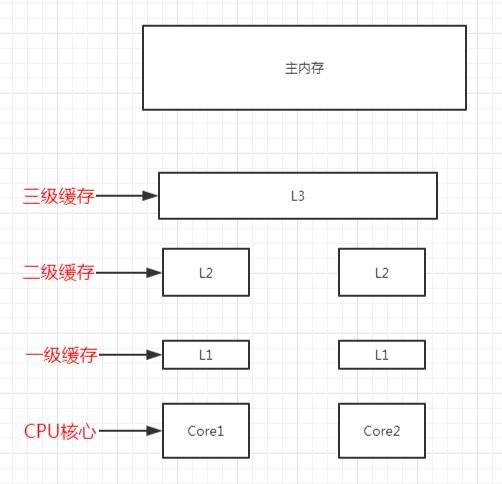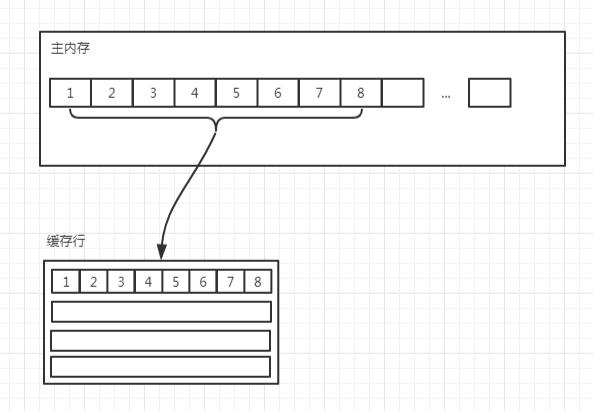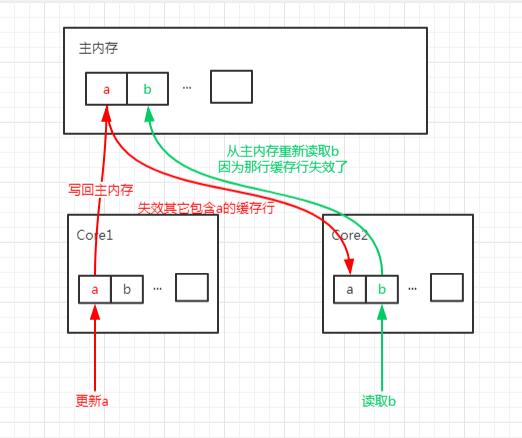什么是CPU缓存
在计算机系统中,CPU高速缓存是用于减少处理器访问内存所需平均时间的部件。在金字塔式存储体系中它位于自顶向下的第二层,仅次于CPU寄存器。其容量远小于内存,但速度却可以接近处理器的频率。
当处理器发出内存访问请求时,会先查看缓存内是否有请求数据。如果存在(命中),则不经访问内存直接返回该数据;如果不存在(失效),则要先把内存中的相应数据载入缓存,再将其返回处理器。

为什么需要CPU缓存
随着工艺的提升,最近几十年 CPU 的频率不断提升,而受制于制造工艺和成本限制,目前计算机的内存在访问速度上没有质的突破。因此,CPU 的处理速度和内存的访问速度差距越来越大,甚至可以达到上万倍。这种情况下传统的 CPU 直连内存的方式显然就会因为内存访问的等待,导致计算资源大量闲置,降低 CPU 整体吞吐量。同时又由于内存数据访问的热点集中性,在 CPU 和内存之间用较为快速而成本较高(相对于内存)的介质做一层缓存,就显得性价比极高了。
为什么需要有CPU多级缓存
- 各种寄存器,用来存储本地变量和函数参数,访问一次需要1cycle,耗时小于1ns;
- L1 Cache,一级缓存,本地 core 的缓存,分成 32K 的数据缓存 L1d 和 32k 指令缓存 L1i,访问 L1 需要3cycles,耗时大约 1ns;
- L2 Cache,二级缓存,本地 core 的缓存,被设计为 L1 缓存与共享的 L3 缓存之间的缓冲,大小为 256K,访问 L2 需要 12cycles,耗时大约 3ns;
- L3 Cache,三级缓存,在同插槽的所有 core 共享 L3 缓存,分为多个 2M 的段,访问 L3 需要 38cycles,耗时大约 12ns;
大致可以得出结论,缓存层级越接近于 CPU core,容量越小,速度越快,当 CPU 执行运算的时候,它先去 L1 查找所需的数据,再去 L2,然后是 L3,最后如果这些缓存中都没有,所需的数据就要去主内存拿。走得越远,运算耗费的时间就越长。
什么是缓存行
缓存行 (Cache Line) 便是 CPU Cache 中的最小单位,CPU Cache 由若干缓存行组成,一个缓存行的大小通常是 64 字节(这取决于 CPU),并且它有效地引用主内存中的一块地址。一个 Java 的 long 类型是 8 字节,因此在一个缓存行中可以存 8 个 long 类型的变量。

猜一下下面代码的执行时间:
- public class ArrayLoop {
- public static void main(String[] args) {
- long[][] arr = new long[1024 * 1024][8];
- long sum = 0;
- //横向遍历
- long start = System.currentTimeMillis();
- for (int i = 0; i < 1024 *1024; i++) {
- for (int j = 0; j < 8; j++) {
- sum += arr[i][j];
- }
- }
- System.out.println("横向遍历耗时:" + (System.currentTimeMillis() - start) + "ms");
- //纵向遍历
- start = System.currentTimeMillis();
- for (int i = 0; i < 8; i++) {
- for (int j = 0; j < 1024 * 1024; j++) {
- sum += arr[j][i];
- }
- }
- System.out.println("纵向遍历耗时:" + (System.currentTimeMillis() - start) + "ms");
- }
- }
在我电脑上的执行时间为:
横向遍历耗时:32ms
纵向遍历耗时:88ms
在程序运行的过程中,缓存每次更新都从主内存中加载连续的 64 个字节。因此,如果访问一个 long 类型的数组时,当数组中的一个值被加载到缓存中时,另外 7 个元素也会被加载到缓存中。
什么是伪共享

如果多个线程的变量共享了同一个 CacheLine,任意一方的修改操作都会使得整个 CacheLine 失效(因为 CacheLine 是 CPU 缓存的最小单位),也就意味着,频繁的多线程操作,CPU 缓存将会彻底失效,降级为 CPU core 和主内存的直接交互。
如何避免伪共享
使用了字节填充技术(空间换时间)解决伪共享;
- public final class FalseSharing implements Runnable {
- public final static int NUM_THREADS = 4; // change
- public final static long ITERATIONS = 500L * 1000L * 1000L;
- private final int arrayIndex;
- private static VolatileLong[] longs = new VolatileLong[NUM_THREADS];
- static {
- for (int i = 0; i < longs.length; i++) {
- longs[i] = new VolatileLong();
- }
- }
- public FalseSharing(final int arrayIndex) {
- this.arrayIndex = arrayIndex;
- }
- public static void main(final String[] args) throws Exception {
- final long start = System.currentTimeMillis();
- runTest();
- System.out.println("duration = " + (System.currentTimeMillis() - start));
- }
- private static void runTest() throws InterruptedException {
- Thread[] threads = new Thread[NUM_THREADS];
- for (int i = 0; i < threads.length; i++) {
- threads[i] = new Thread(new FalseSharing(i));
- }
- for (Thread t : threads) {
- t.start();
- }
- for (Thread t : threads) {
- t.join();
- }
- }
- public void run() {
- long i = ITERATIONS + 1;
- while (0 != --i) {
- longs[arrayIndex].value = i;
- }
- }
- public final static class VolatileLong {
- public volatile long value = 0L;
- public long p1, p2, p3, p4, p5, p6; // 填充,可以注释后对比测试
- }
- }
Java8 中实现字节填充
- @Retention(RetentionPolicy.RUNTIME)
- @Target({ElementType.FIELD, ElementType.TYPE})
- public @interface Contended {
- String value() default "";
- }
注意需要同时开启 JVM 参数:-XX:-RestrictContended=false
@Contended 注解会增加目标实例大小,要谨慎使用。默认情况下,除了 JDK 内部的类,JVM 会忽略该注解。要应用代码支持的话,要设置 -XX:-RestrictContended=false,它默认为 true(意味仅限 JDK 内部的类使用)。当然,也有个 –XX: EnableContented 的配置参数,来控制开启和关闭该注解的功能,默认是 true,如果改为 false,可以减少 Thread 和 ConcurrentHashMap 类的大小。参加《Java性能权威指南》210 页。
ConcurrentHashMap 中,使用 @sun.misc.Contended 对静态内部类 CounterCell 进行修饰。另外还包括并发容器 Exchanger 也有相同的操作。
- /* ---------------- Counter support -------------- */
- /**
- * A padded cell for distributing counts. Adapted from LongAdder
- * and Striped64. See their internal docs for explanation.
- */
- @sun.misc.Contended static final class CounterCell {
- volatile long value;
- CounterCell(long x) { value = x; }
- }
Thread 线程类的源码中,使用 @sun.misc.Contended 对成员变量进行修饰。
- // The following three initially uninitialized fields are exclusively
- // managed by class java.util.concurrent.ThreadLocalRandom. These
- // fields are used to build the high-performance PRNGs in the
- // concurrent code, and we can not risk accidental false sharing.
- // Hence, the fields are isolated with @Contended.
- /** The current seed for a ThreadLocalRandom */
- @sun.misc.Contended("tlr")
- long threadLocalRandomSeed;
- /** Probe hash value; nonzero if threadLocalRandomSeed initialized */
- @sun.misc.Contended("tlr")
- int threadLocalRandomProbe;
- /** Secondary seed isolated from public ThreadLocalRandom sequence */
- @sun.misc.Contended("tlr")
- int threadLocalRandomSecondarySeed;
参考:
https://juejin.im/post/5c471d75e51d45299a08b333
https://juejin.im/post/5cd644886fb9a032136fe6d7































